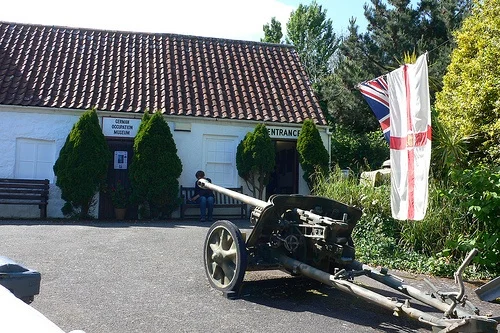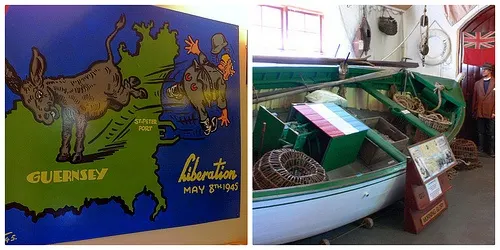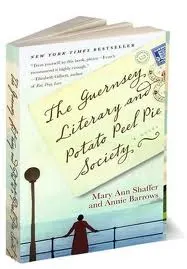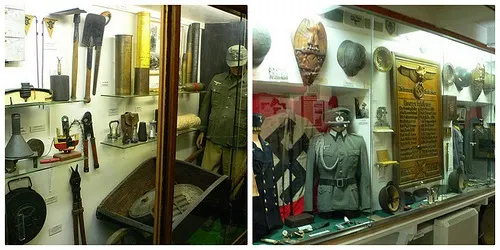Of course I knew that Guernsey was occupied during the Second World War, but somehow I imagined that the local people led a cozy existence, shielded from the hardships of war. Once I visited Guernsey I realized that the opposite was true and that Guernsey had an incredibly tough time during the German Occupation.
All over the island we noticed evidence of the German coastal fortifications; the look-out on the headland at Jerbourg point; the slit built into garden wall as we walked back down the lane to Sausmarez Manor; the concrete bunkers on the northern shore covered with grass and wildflowers, next to sandy beaches that were covered with barbed wire during the war.
A Brief History
In June 1940 a bombing raid on the harbor at St Peter Port was followed by the landing of German troops on Guernsey, the British Government having decided that the Channel Islands would not be defended and for the next 5 years the people of Guernsey lived under occupation.
After D-day the Channel islands could not be resupplied from France and during the final year of the occupation, the population faced near starvation until relief came in the form of the Red Cross ship Vega. Finally the Germans surrendered on 9 May 1945 and every year on this day the people of Guernsey celebrate their Liberation day.
Visiting the German Occupation Museum
As my kids and I are all history enthusiasts, we were keen to visit the German Occupation Museum at Les Houards, and learn more about the wartime years on Guernsey. The low, whitewashed building was unassuming and looked from the outside like any traditional farmhouse.
On entering we found that the museum extended into a much larger building with a series of rooms, packed with glass cases of uniforms, military and household objects and artefacts from the Second World War. We watched an interesting video about the history of the occupation and wandered around trying to make sense of what we were seeing.
The Different Rooms
Each of the rooms were arranged in a theme and there was a slightly homemade air about the museum, as if all the interesting bits and pieces that everyone on Guernsey had been storing in their attics had been brought out to tell the story of what they had lived through.
One of the room sets showed a family scene where the father was on a radio listening to news from the mainland while the mother was keeping watch at the window to make sure they were not discovered, as it was a serious offence to have a radio. Another room gave information about all the food substitutes that had to be used for everyday staples like tea, coffee and tobacco, while vegetables were cooked in sea water in the absence of any salt.
The diet seemed to consist mainly of root vegetables and even fishing was heavily restricted as the Germans were afraid that anyone with a boat would try to escape back to England as some had done early in the war.
Walking Around the 2-floored Museum
Upstairs, the museum opened out into a street scene with people queuing to collect their rations outside a shop, and there was even a large fishing boat to tell the story of how the fishing was controlled by the Germans.
The Museum gave a fascinating insight to life during the German Occupation and you could easily spend a couple of hours or more watching the videos and looking at all the information. Downstairs there was also a nice little tea room where you could finish your visit with a cup of tea and a cake. The German Occupation Museum would make an ideal rainy day option or be combined with a walk along the coastal path near Petit Bot Bay and Saints Bay.
Personal accounts of the occupation
Ask anyone brought up on Guernsey and they will have some tales of how their family weathered the war years. Children were evacuated, those who opposed the German forces were imprisoned or deported to French or German internment camps, fishermen were not allowed to fish and towards the end of the occupation the population were literally starving. I spoke to Gill Girard, a guide on Guernsey who told me her family’s story.
My grandmother and her children got evacuated but my grandfather was left behind. He had a little business in St Peter Port that he was closing up and the boats didn’t come back – he had every intention of following my grandmother but he got stuck here. I still have letters that they wrote when they were trying to communicate with each other during the Occupation.
My husband’s mother and father stayed here during the Occupation as she had her first child at the time of the evacuation. Fortunately they lived on a farm so they were able to secrete root vegetables away and they weren’t quite as hungry as some people. My father was a headmaster so he ended up educating the children who were left here during the Occupation.
The Guernsey Literary and Potato Peel Pie Society
I often try to find holiday reading about the places I visit, so I took the novel “The Guernsey Literary and Potato Peel Pie Society” with me during our trip to Guernsey. This novel has been taking the book clubs by storm and brings to life the war years on the island through a series of letters from different characters who lived through the occupation.
The heroine, Juliet, is a wartime journalist, living in London who strikes up a chance correspondence with a Guernsey farmer, Dawsey, who is a member of a literary club on Guernsey.
As Juliet decides to write an article about the wartime experiences on Guernsey, she receives further letters from other members of the group, who had met one evening to share a meal of a secretly slaughtered pig, but had come up with the cover story of a literary society as an excuse to avoid arrest after the Germans stop them on their way home after curfew.
The Potato Peel Pie Society
The potato peel pie came about because they wanted to share a meal each time they met, but with little available they made a pie of root vegetables using potato peel as a pie crust. Through her correspondence with the members of the literary society, Juliet finds out about life under the German Occupation and she also hears stories of her alter ego, a woman named Elizabeth who was the pivot of the group and had a child with a German doctor working on the island. Juliet eventually visits Guernsey and settles there, falling in love both with the island and with Dawsey.
The book is planned to be made into a film directed by English director Kenneth Branagh who visited the island in spring 2012 to look for locations. It is hoped that some of the filming will take place on Guernsey during 2013 with Kate Winslet in the leading role of Juliet.
If you’d like to find more about the locations mentioned in the book, Gill Girard runs guided tours on this theme and there is also an information leaflet that you can pick up at the tourism office in St Peter Port.
More Guernsey locations to find out about the German Occupation
If you’d like to find out more about the wartime occupation of the Channel Islands you can check the website of the Channel Island Occupation Society. You may also like to seek out some of the other wartime locations that are open to visit and you can find more details on the Visit Guernsey Website
Close to St Peter Port
La Vallette Underground Military Museum, La Valette, St Peter Port GY1 1AX
This military museum is housed in air conditioned tunnels that were built by the Germans to store fuel for U-boats and illustrates Guernsey’s military history, including World War 1 and the German Occupation.
German Naval Signals HQ, St Jacques, St Peter Port GY1 1SN
This was the Headquarters of the German Naval Command on the Channel Islands. The Signal HQ was responsible for all radio traffic to and from Germany and the other Islands, until the German surrender in 1945.
South and South-West Guernsey
German Occupation Museum, Les Houards Forest, GY8 0BG
The museum was opened in 1966 by Richard Heaume, a founder member of the Occupation Society giving a flavor of life on Guernsey during the Second World War, with an authentic occupation street and a collection of WW2 relics from Guernsey.
German Military Underground Hospital, Les Éperons La Vaissellerie, GY6 8XR
Underground tunnels covering 7000 square Meters that were used for the military hospital, hewn out of solid rock by slave workers of different nationalities for the German forces 1940-1945.
Pleinmont Observation Tower, Pleinmont Headland, Torteval
A five-story naval observation tower used by Germans 1942-45, with the navy using the top three levels for their batteries and the two lower levels were taken over by the army. Nearby is the Batterie Dollmann Gun Pit, with a restored battery gun pit that houses a 10 ton French gun
North Coast of Guernsey
Fort Hommet Gun CaseMate, Fort Hommet Headland Vazon Castel
One of 21 ‘Fortress’ bunkers built in Guernsey that was operational in 1943-45, build to house the German Guns, four of which were installed here at Fort Hommet.
More tales from our trip to Guernsey
A meander around St Peter Port and our stay at Albany Apartments
Our Spring Break on Guernsey and Sark – Podcast
Family Impressions of Guernsey – French, English, neither or both?
Visitor Information for Guernsey and St Peter Port
Guernsey Information – You’ll find more things to see and do on the Visit Guernsey website
Accommodation on Guernsey – We stayed at Albany Apartments, a family friendly self catering holiday apartment in St peter Port and we also stayed at St Pierre Park Hotel, a pleasant, 4 star hotel with golf course set in parkland beside a lake.
Getting to Guernsey and Around – We flew to Guernsey with Aurigny Airlines who fly to Guernsey from Bristol and other UK destinations. You can also book flights with Blue Islands Airlines and take the ferry with Condor Ferries from Poole or Portsmouth. We picked up our hire car from Hertz at the airport, who are also able to deliver your hire car to your holiday accommodation.
Reading for Guernsey – I highly recommend the novel, the Guernsey Literary and Potato Peel Pie Society For walks on Guernsey, we used my Cicerone guide to Walks on Guernsey and a good general travel guide to Guernsey is the Landmark Visitor’s Guide to Guernsey, Alderney, Sark & Herm
This article may contain affiliate links that provide commission on purchases you make at no extra cost to you. As an Amazon Associate I earn from qualifying purchases.







Lorraine Hozian
Monday 15th of April 2024
Interested in German reaction to Guernsey Literary and Potato Peel Society. My grandparents were under occupation during 1st World War/
Heather Cowper
Tuesday 16th of April 2024
@Lorraine Yes, that would certainly give a different perspective, war causes suffering for everyone.
L Knight
Wednesday 6th of May 2015
Does anyone know snything about a John snd Ethel Noble who had Petite Bot hotel before war + alsation. They managed to evacuate
e to UK and returned after war running hotel again. Xmas 1962 John went alone on cruise on ship Lakonia which had deadly fire and many caualties . His body was landed at Gibraltar and buried and then repatriated somewhere. Destination not recorded in Gib. He was originally from N E England
And married Guernsey girl Ethel.
crunch
Sunday 5th of May 2013
gotta go to L'angle tower, visible from car park C at Piermont Tower, can see the towers and views any day of the week.
Heather Cowper
Sunday 5th of May 2013
@Crunch Thanks for the Guernsey tip
Kendra Cheung
Tuesday 23rd of April 2013
When I originally commented I clicked the "Notify me when new comments are added" checkbox and now each time a
comment is added I get several e-mails with the same comment. Is there any way you can remove me from that service? Appreciate it!
Save Your Link to Us
Sunday 27th of January 2013
Guernsey - the German Occupation and Potato Peel Pie | Heather on her travels...
A history of the German Occupation of Guernsey, the German Occupation Museum, Local wartime experiences and a taste of Potato Peel Pie...